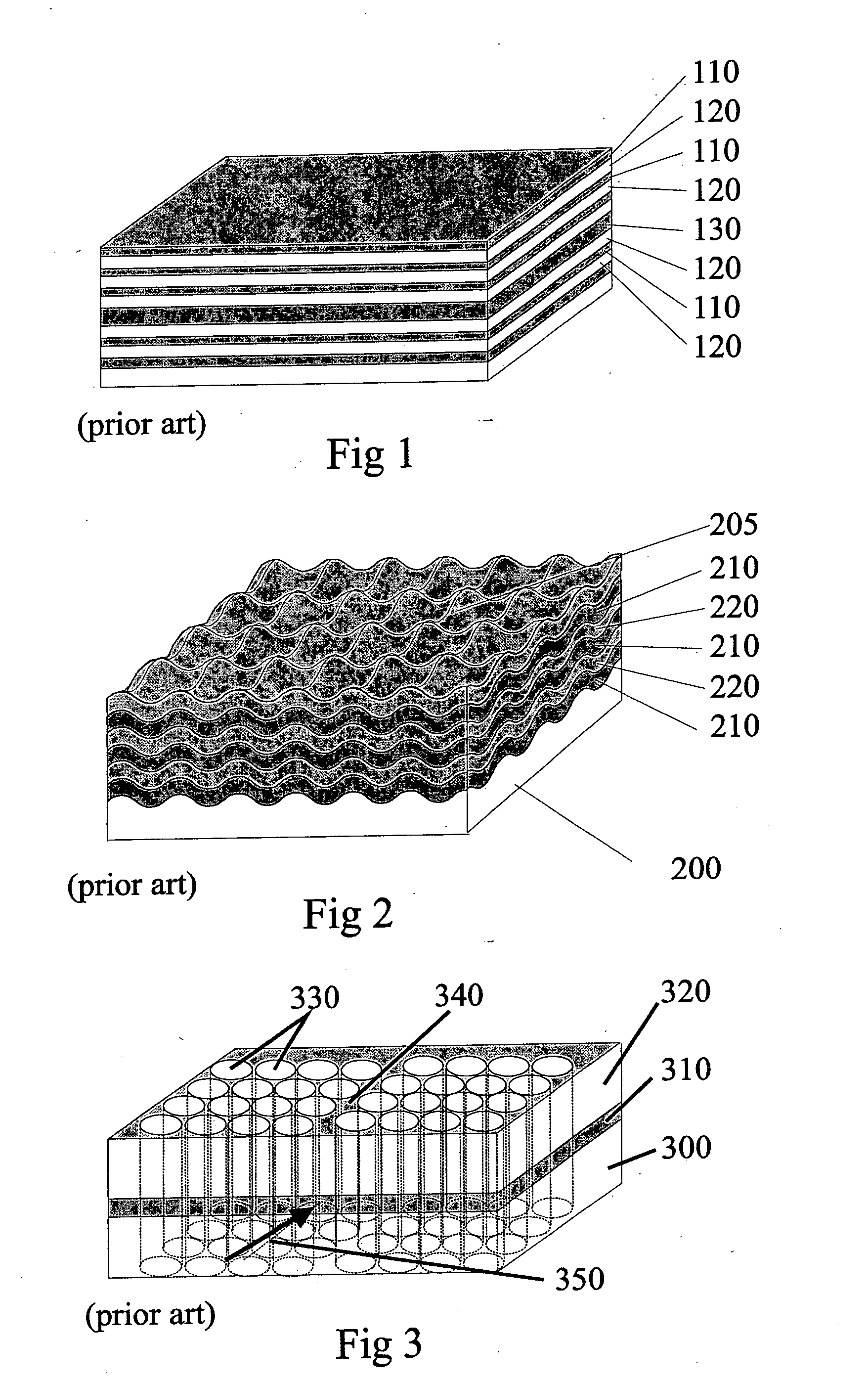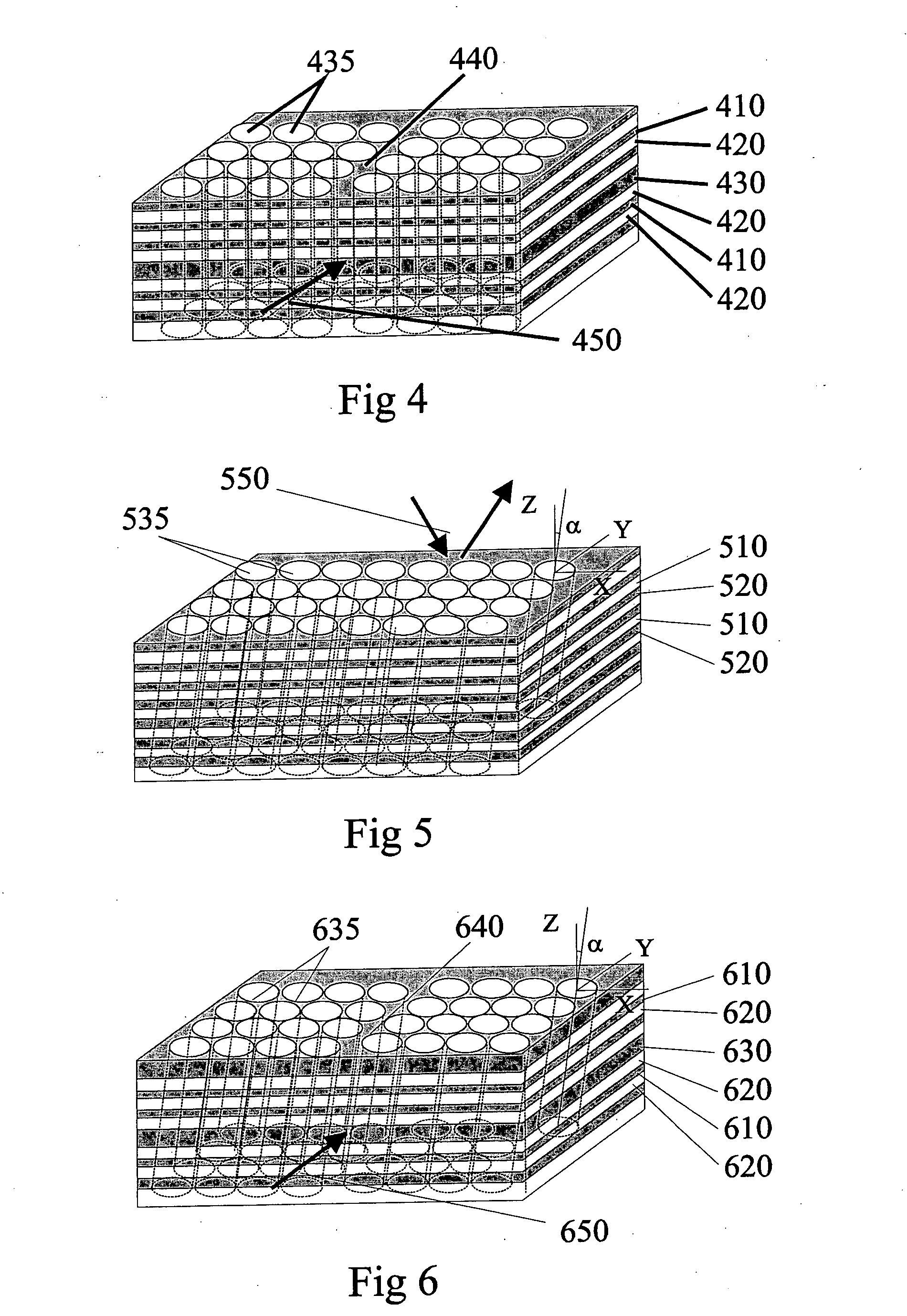Intergrated photonic crystal structure and method of producing same
- Summary
- Abstract
- Description
- Claims
- Application Information
AI Technical Summary
Benefits of technology
Problems solved by technology
Method used
Image
Examples
example 1
[0155] This example concerns an aspect of the present invention with .alpha.=1.degree.. Said first surface is periodic and two-dimensional with the tangent plane (of said first surface) being a plane parallel to the (x, y) plane of a Cartesian coordinate system (x, y, z). Let a.sub.1=.LAMBDA..sub..zeta.({square root}{square root over (3)} x+y) / 2 and a.sub.2=.LAMBDA..sub..zeta.({square root}{square root over (3)} x-y) / 2 be two basis vectors that span the (x,y) plane characterising a two-dimensional triangular crystal lattice with lattice constant .LAMBDA..sub..zeta., and a.sub.3=.LAMBDA..sub.zz be a third basis vector, x, y, and z being the Cartesian vectors of unit length.
[0156] Said first surface is defined as the set of points (x, y, z=S(.zeta..sub.1, .zeta..sub.2)) where S(.zeta..sub.1, .zeta..sub.2)=A.sub..zeta. sin(2.pi. .zeta..sub.1 / .LAMBDA..sub..zeta.) sin(2.pi. .zeta..sub.2 / .LAMBDA..sub..zeta.)-t.sub.a / 2, where the coordinate pair (.zeta..sub.1,.zeta..sub.2) describes the (x...
example 2
[0160] This example concerns an aspect of the present invention in the case where said first surface is planar and the intersecting angle of the second structure .alpha.=35.26.degree.. In the following the (x,y) plane of a Cartesian coordinate system (x, y, z) is set parallel to the surface. A layered structure is formed by depositing layer A with refractive index n.sub.a and thickness t.sub.a followed by layer B with refractive index n.sub.b and thickness t.sub.b in alternance. The period of this multilayer stack is .LAMBDA..sub.z=t.sub.a+t.sub.b, which is the length of the unit of two layers that is repeated. In this example, the units are repeated an infinite number of times, but in reality approximately 10 to 20 units will be sufficient.
[0161] Let (x', y', z') be a second Cartesian coordinate system where the z'-axis and the z-axis intersect at the angle .alpha., and let a.sub.1=.LAMBDA.({square root}{square root over (3)} x+y) / 2 and a.sub.2=.LAMBDA.({square root}{square root ov...
example 3
[0165] This example concerns an aspect of the present invention in the case where the first surface is planar and the intersecting angle of the second structure .alpha.=0.degree.. In the following the (x,y) plane of a Cartesian coordinate system (x, y, z) is set parallel to the surface. A layered structure is formed by depositing layer A with refractive index n.sub.a and thickness t.sub.a followed by layer B with refractive index n.sub.b and thickness t.sub.b in alternance. The period of this multilayer stack is .LAMBDA..sub.z=t.sub.a+t.sub.b, which is the length of the unit of two layers that is repeated. In this example, the units are repeated an infinite number of times, but in reality approximately 10 to 20 units will be sufficient.
[0166] Let (x', y', z') be a second Cartesian coordinate system where the z'-axis and the z-axis intersect at an angle .alpha., and let a.sub.1=.LAMBDA.({square root}{square root over (3)} x+y) / 2 and a.sub.2=.LAMBDA.({square root}{square root over (3)...
PUM
 Login to View More
Login to View More Abstract
Description
Claims
Application Information
 Login to View More
Login to View More - R&D
- Intellectual Property
- Life Sciences
- Materials
- Tech Scout
- Unparalleled Data Quality
- Higher Quality Content
- 60% Fewer Hallucinations
Browse by: Latest US Patents, China's latest patents, Technical Efficacy Thesaurus, Application Domain, Technology Topic, Popular Technical Reports.
© 2025 PatSnap. All rights reserved.Legal|Privacy policy|Modern Slavery Act Transparency Statement|Sitemap|About US| Contact US: help@patsnap.com



